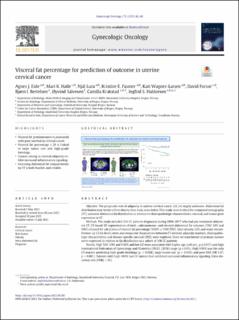| dc.contributor.author | Eide, Agnes J. | |
| dc.contributor.author | Halle, Mari Kyllesø | |
| dc.contributor.author | Lura, Njål | |
| dc.contributor.author | Fasmer, Kristine Eldevik | |
| dc.contributor.author | Wagner-Larsen, Kari Strøno | |
| dc.contributor.author | Forsse, David Erik | |
| dc.contributor.author | Bertelsen, Bjørn | |
| dc.contributor.author | Salvesen, Øyvind Olav | |
| dc.contributor.author | Krakstad, Camilla | |
| dc.contributor.author | Haldorsen, Ingfrid S. | |
| dc.date.accessioned | 2024-02-12T11:54:57Z | |
| dc.date.available | 2024-02-12T11:54:57Z | |
| dc.date.created | 2023-08-28T12:20:32Z | |
| dc.date.issued | 2023 | |
| dc.identifier.issn | 0090-8258 | |
| dc.identifier.uri | https://hdl.handle.net/11250/3116948 | |
| dc.description.abstract | Objective
The prognostic role of adiposity in uterine cervical cancer (CC) is largely unknown. Abdominal fat distribution may better reflect obesity than body mass index. This study aims to describe computed tomography (CT)-assessed abdominal fat distribution in relation to clinicopathologic characteristics, survival, and tumor gene expression in CC.
Methods
The study included 316 CC patients diagnosed during 2004–2017 who had pre-treatment abdominal CT. CT-based 3D segmentation of total-, subcutaneous- and visceral abdominal fat volumes (TAV, SAV and VAV) allowed for calculation of visceral fat percentage (VAV% = VAV/TAV). Liver density (LD) and waist circumference (at L3/L4-level) were also measured. Associations between CT-derived adiposity markers, clinicopathologic characteristics and disease-specific survival (DSS) were explored. Gene set enrichment of primary tumors were examined in relation to fat distribution in a subset of 108 CC patients.
Results
High TAV, VAV and VAV% and low LD were associated with higher age (≥44 yrs.; p ≤ 0.017) and high International Federation of Gynecology and Obstetrics (FIGO) (2018) stage (p ≤ 0.01). High VAV% was the only CT-marker predicting high-grade histology (p = 0.028), large tumor size (p = 0.016) and poor DSS (HR 1.07, p < 0.001). Patients with high VAV% had CC tumors that exhibited increased inflammatory signaling (false discovery rate [FDR] < 5%).
Conclusions
High VAV% is associated with high-risk clinical features and predicts reduced DSS in CC patients. Furthermore, patients with high VAV% had upregulated inflammatory tumor signaling, suggesting that the metabolic environment induced by visceral adiposity contributes to tumor progression in CC. | en_US |
| dc.language.iso | eng | en_US |
| dc.publisher | Elsevier | en_US |
| dc.rights | Navngivelse 4.0 Internasjonal | * |
| dc.rights.uri | http://creativecommons.org/licenses/by/4.0/deed.no | * |
| dc.title | Visceral fat percentage for prediction of outcome in uterine cervical cancer | en_US |
| dc.type | Journal article | en_US |
| dc.type | Peer reviewed | en_US |
| dc.description.version | publishedVersion | en_US |
| dc.rights.holder | Copyright 2023 The Author(s) | en_US |
| cristin.ispublished | true | |
| cristin.fulltext | original | |
| cristin.qualitycode | 2 | |
| dc.identifier.doi | 10.1016/j.ygyno.2023.06.581 | |
| dc.identifier.cristin | 2170171 | |
| dc.source.journal | Gynecologic Oncology | en_US |
| dc.source.pagenumber | 62-68 | en_US |
| dc.identifier.citation | Gynecologic Oncology. 2023, 176, 62-68. | en_US |
| dc.source.volume | 176 | en_US |

